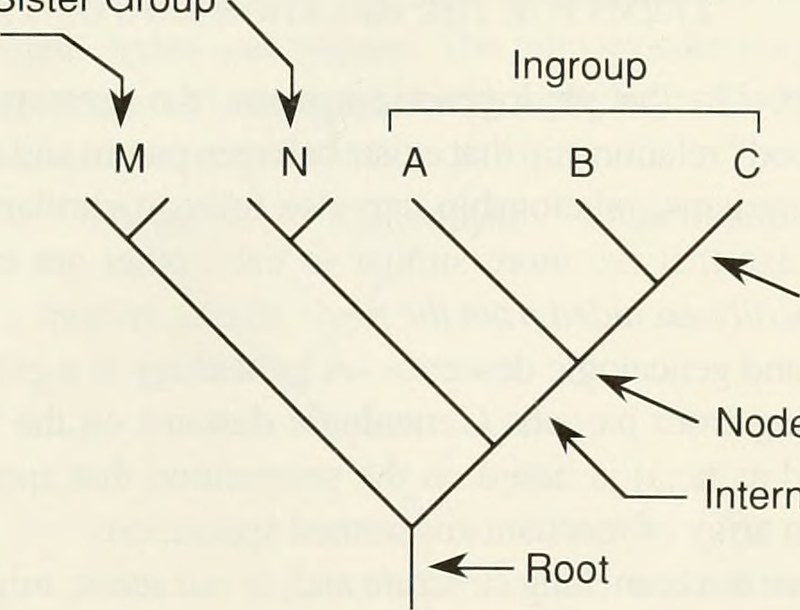The key difference between ingroup and outgroup in biology is that an ingroup is a group of closely related taxa that is investigated for evolutionary relationships while outgroup is a reference group or a taxon outside the group of interest and more distantly related to the ingroup.
Cladistics or phylogenetics is the most commonly used method in biological classification. It uses the most recent common ancestor to categorize organisms into groups or clades. Cladistic analysis finally produces a cladogram, which is a tree-shaped diagram representing the phylogenetic relationships between organisms. Thus, cladistics helps to determine evolutionary relationships between species, especially monophyletic organisms. Outgroup and ingroup are two groups defined in cladistics. The ingroup is the group of taxa that is investigated for determining evolutionary relationships. They are closely related taxa or sister taxa. In contrast, an outgroup is a reference group that is outside the group of interest. The outgroup is distantly related to the ingroup.
CONTENTS
1. Overview and Key Difference
2. What is Ingroup in Biology
3. What is Outgroup in Biology
4. Similarities Between Ingroup and Outgroup in Biology
5. Side by Side Comparison – Ingroup vs Outgroup in Biology in Tabular Form
6. Summary
What is Ingroup in Biology?
Ingroup in biology is a group of taxa that is considered in determining evolutionary relationships. The taxa in an ingroup are closely related. In fact, they are sister groups, and they share a common ancestor. Therefore, taxa in an ingroup are descendants that split from the same node in the cladogram.

Figure 01: Ingroup
What is Outgroup in Biology?
Outgroup in biology is a reference group used in determining evolutionary relationships between monophyletic organisms. The outgroup is a distantly related taxon to the group of interest, and it stems from the base of the tree. Therefore, it lies outside the group of interest. In simple words, the outgroup does not belong to the group which is being investigated for evolutionary relationships. However, it works as a point of comparison for the ingroup when phylogeny is rooted.

Figure 02: Ingroup and Outgroup
Moreover, the outgroup helps in assessing the characteristics of the ingroup. It gives an idea about the location of the main group in a big phylogenetic tree. Also, outgroups are very useful in constructing evolutionary trees.
What are the Similarities Between Ingroup and Outgroup in Biology?
- Both ingroup and outgroup are important in determining evolutionary relationships between monophyletic organisms.
- The cladogram shows both ingroups and outgroups.
- The outgroup is useful in assessing the characteristics of the ingroup.
- Moreover, outgroup works as a point of comparison for the ingroup when phylogeny is rooted.
What is the Difference Between Ingroup and Outgroup in Biology?
The ingroup is a set of taxa that is investigated for evolutionary relationships, while outgroup is a reference group that is distantly related to the group being analyzed. So, this is the key difference between ingroup and outgroup in biology. Moreover, taxa of the ingroup are hypothesized to be more closely related to each other. Meanwhile, a taxon in outgroup is hypothesized to be less closely related to each of the taxa under consideration. Furthermore, taxa in an ingroup sharing a common ancestor while outgroup does not share a common ancestor with ingroup taxa.
The below infographic summarizes the difference between ingroup and outgroup in biology.

Summary – Ingroup vs Outgroup in Biology
The ingroup is the set of taxa which is hypothesized to be more closely related to each other. Thus, taxa in the ingroup are sister groups of each other. An outgroup is a group of organisms that serves as a reference group in determining the evolutionary relationships of the ingroup. The outgroup is hypothesized to be less closely related to each of the taxa in ingroup. So, it lies outside the ingroup, and it does not share a common ancestor with the ingroup. So, this summarizes the difference between ingroup and outgroup in biology.
Reference:
1.“Phylogenetic Systematics, A.k.a. Evolutionary Trees.” Reading Trees: A Quick Review, Available here.
2. “Outgroup (Cladistics).” Wikipedia, Wikimedia Foundation, 13 Oct. 2019, Available here.
Image Courtesy:
1. “Image from page 22 of “The Compleat cladist : a primer of phylogenetic procedures” (1991)” By Internet Archive Book Images via Flickr
2. “Outgroup” By Ngilbert202 – Own work (CC BY-SA 4.0) via Commons Wikimedia
ncG1vNJzZmivp6x7pbXFn5yrnZ6YsqOx07CcnqZemLyue8OinZ%2Bdopq7pLGMm5ytr5Wau261zaCpqK2gYq6vsIyorK2foqTCsXnIp2SboZ%2BhvKjFjg%3D%3D